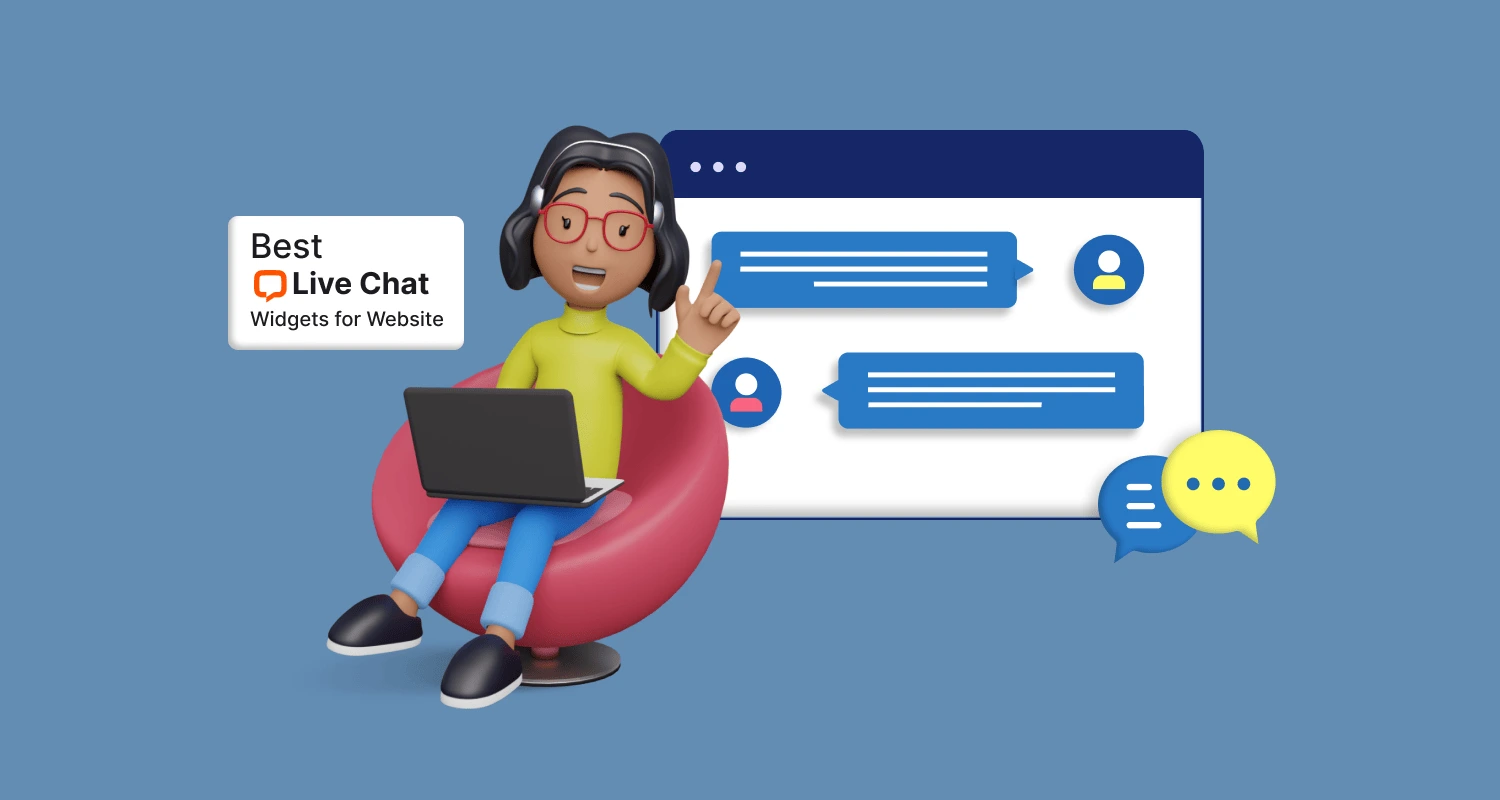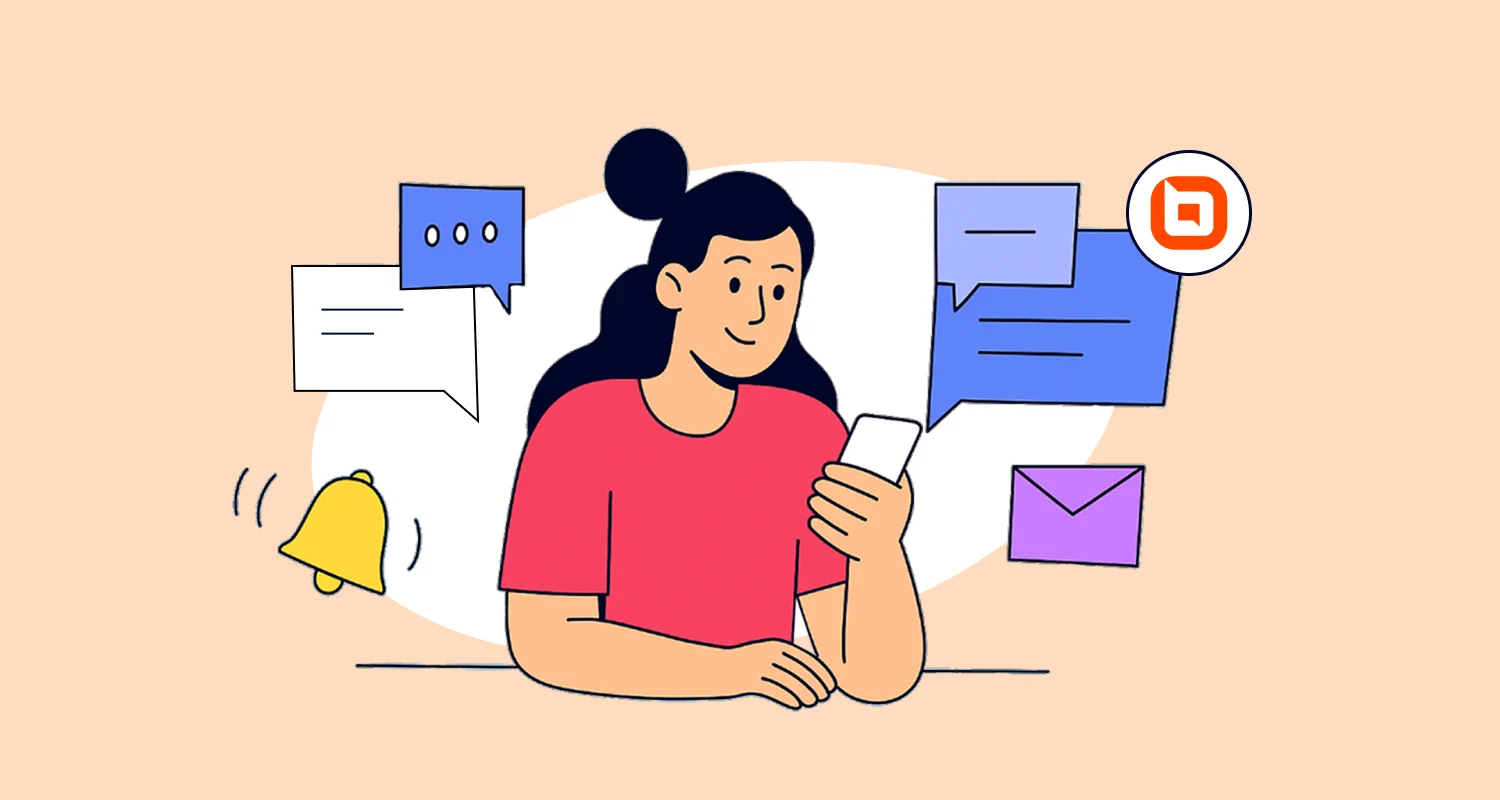Live chat widgets have become an essential tool for businesses looking to boost client engagement and provide real-time support.
Zippia reports that live chat support is the preferred communication method for 41% of customers compared to alternative options.
Imagine walking into a shop and being welcomed by a friendly assistant, ready to answer your inquiries and guide you toward the perfect product. That’s the magic of live chat widgets, the small chat windows that pop up on websites, offering immediate assistance and connection to your customers.
Numerous firms provide live chat software options. In this article, we’ll delve into their cost, capabilities, advantages, and drawbacks to offer you a comprehensive overview of your choices.
What is a live chat widget?
A live chat widget is a small software application that can be added to a website, enabling visitors to communicate with company representatives in real-time.
It normally appears as a chat box, often in the bottom left or right corner of a website, and it can be activated by clicking on it. Once activated, users can type messages and interact directly with support agents or automated chatbots.
Implementing a chat website widget is an investment in your customer experience and business growth. It’s a chance to connect with your customers directly, build trust, and create a more engaging and satisfying experience.
How does live chat work?
Live chat functions as a real-time communication tool that enables instant interaction between website visitors or users and customer support agents.
Usually embedded on a website or within a web application, a live chat system presents a visible chat box where users can initiate conversations.
Here is how it works:
- Users can either click on the chat box or trigger options that automatically open the chat based on specific criteria.
- Once initiated, the chat system captures user details and routes the conversation to an available support agent.
- Users and agents engage in a text-based conversation within the chat box, exchanging messages, questions, and information.
- After the conversation, the chat can be closed, and in some systems, users may provide feedback.
The system often includes features like file sharing, emojis, and links to enhance communication.
Support representatives can handle multiple chat sessions simultaneously, increasing efficiency. The chat system may integrate with a knowledge base, providing agents with quick access to relevant information.
Live chat software contributes to immediate customer support, encouraging engagement and personalized assistance in real-time, ultimately enhancing the overall user experience.
How to choose an appropriate live chat widget for business?
Choosing the right live chat widget for your business involves considering several factors to ensure it aligns with your specific needs and enhances customer engagement. Here are factors to guide you through the process:
Identify and define your objectives
Identify your company needs and clearly outline the goals to achieve with a chat website widget. Whether it’s improving customer support, increasing sales, or enhancing user engagement, having defined objectives will guide your selection.
Understand your audience
Study the preferences and behaviors of your target audience. A live chat solution that aligns with the communication preferences of your customers will be more effective. For example, if your audience mostly uses mobile devices, choose a solution with strong mobile support.
Consider the ease of use
Select a live chat widget that is user-friendly for both your team and customers. The interface should be intuitive, and setup and customization should be straightforward. This ensures that your team can effectively manage the tool, and customers can easily engage with it.
Check for integration capabilities
Check the integration capabilities of the live chat widget with your existing systems and tools. It should seamlessly integrate with your CRM, help desk, or other relevant software to ensure a unified environment for customer support.
Consider scalability
Choose a chat widget that can scale with your business. Consider factors such as the ability to add more users, handle increased chat volume, and adapt to the growing needs of your customer support operations.
Examine customization options
Look for a live chat widget for website that allows customization to match your brand’s look and feel. The ability to tailor the widget’s appearance, color scheme, and messaging ensures a consistent and branded customer experience.
Monitor mobile responsiveness
With the increasing use of mobile devices, ensure that the live chat widget is mobile-friendly. It should provide a seamless experience for users on smartphones and tablets, allowing them to engage with your business from any device.
Check for security and compliance
Prioritize the security of customer data. Choose a live chat software solution that complies with data protection regulations and industry standards. Look for security features like end-to-end encryption and secure data storage.
Analyze the cost of the chat widget
Understand the pricing model of the live chat widget, whether it’s based on users, features, or usage volume. Consider your budget and choose a solution that provides value for your investment.
Consider free trials and demos
Take advantage of free trials offered by live chat providers. This allows you to test the solution’s functionality and assess its compatibility with your business.
Analytics and reporting
Ensure the chat widget offers robust analytics and reporting features that can help you track chat volume, response time, and customer satisfaction. This lets you make data-driven decisions to improve your service.
Why does your business need a live chat widget?
According to a study from Zippia, 79% of consumers prefer using live chat because they can receive quick responses to inquiries regarding products and customer support matters.
Introducing a live chat widget on a website can offer many advantages for a company, including:
- Immediate customer support: Live chat widgets allow customers to get instant answers to their questions, which can increase customer satisfaction and potentially lead to higher conversion rates.
- Increased sales: By providing immediate assistance, live chat can help guide customers through a purchase, answer any queries about products or services, and reduce the chances of cart abandonment.
- Cost efficiency: Chat website widgets can be more cost-effective than phone support because chat agents can handle multiple conversations at once, reducing the need for a large customer service team.
- Competitive advantage: Offering live chat can set your business apart from competitors who do not provide the same level of instant customer service. The reason is that many customers prefer chatting over other forms of communication because it’s quick, doesn’t require a phone call, and can be done while multitasking. It also shows that your business values customer time and is committed to providing a superior experience.
- Gathering customer insights: Live chat interactions can provide important insights into customer needs and pain points, allowing businesses to improve their products, services, and overall customer experience.
- Proactive engagement: With live chat widgets, businesses can proactively reach out to visitors who seem to be hesitating or in need of help, potentially increasing engagement and sales.
- Building customer relationships: The personalized nature of live chat can build stronger relationships with customers. By having meaningful interactions, your business can foster loyalty and encourage repeat business.
The top live chat widgets for websites (2025)
Selecting the right live chat widget is crucial for enhancing customer interaction and contentment. Below is a list of top live chat widgets for the 2025, designed to assist you in making an informed choice.
1. BoldDesk
BoldDesk is an all-in-one help desk with live chat software that takes real-time support to the next level.
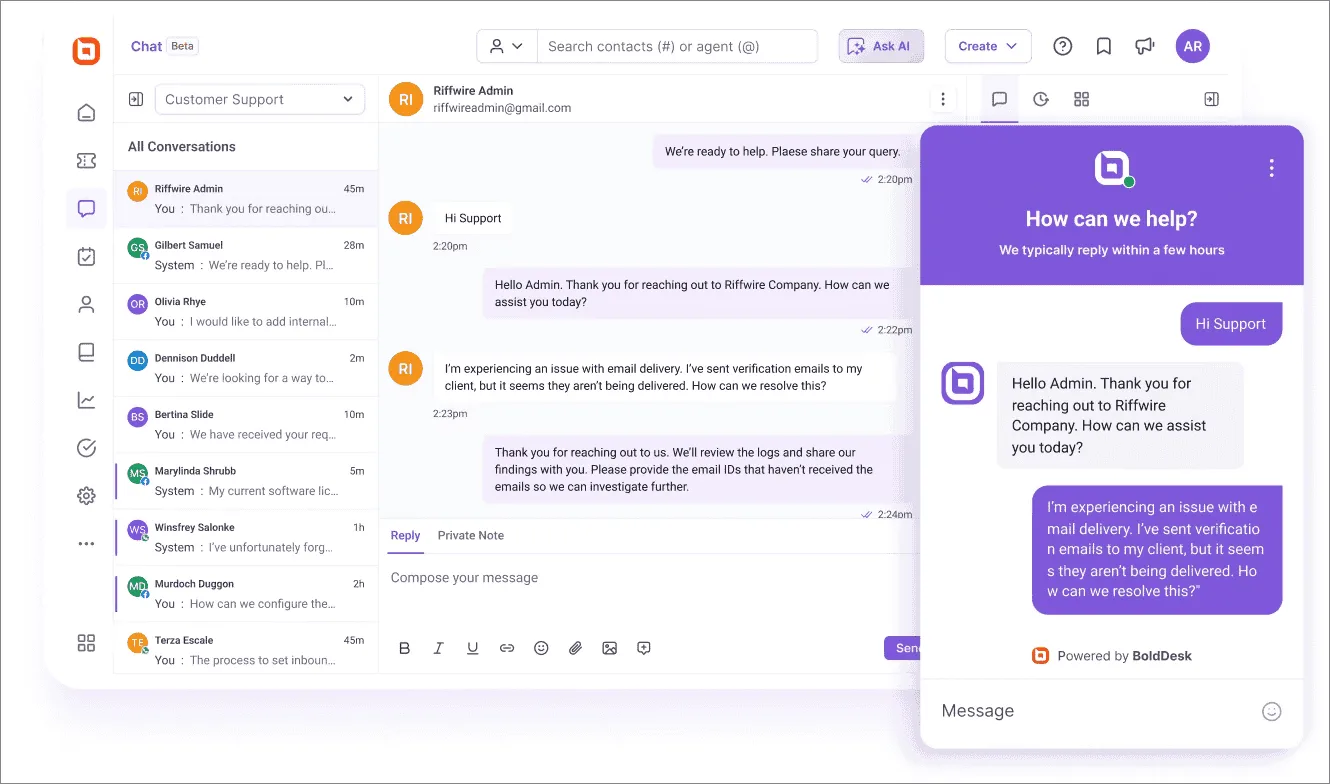
Its customizable live chat widget can be embedded with just one line of code on business websites or apps. Leads and customers can receive immediate and personalized responses right within a company’s site.
Other supported collaboration features, like file sharing and automated canned responses, can make teams more efficient in responding through live chat.
With omnichannel support, customer interaction is even easier, as conversations from all channels can be accessed in one platform. Integrate your Facebook Messenger and WhatsApp apps to make support via chat easier for your team.
Customer requests can also be automatically converted to tickets and routed to the right support agents to easily track and manage.
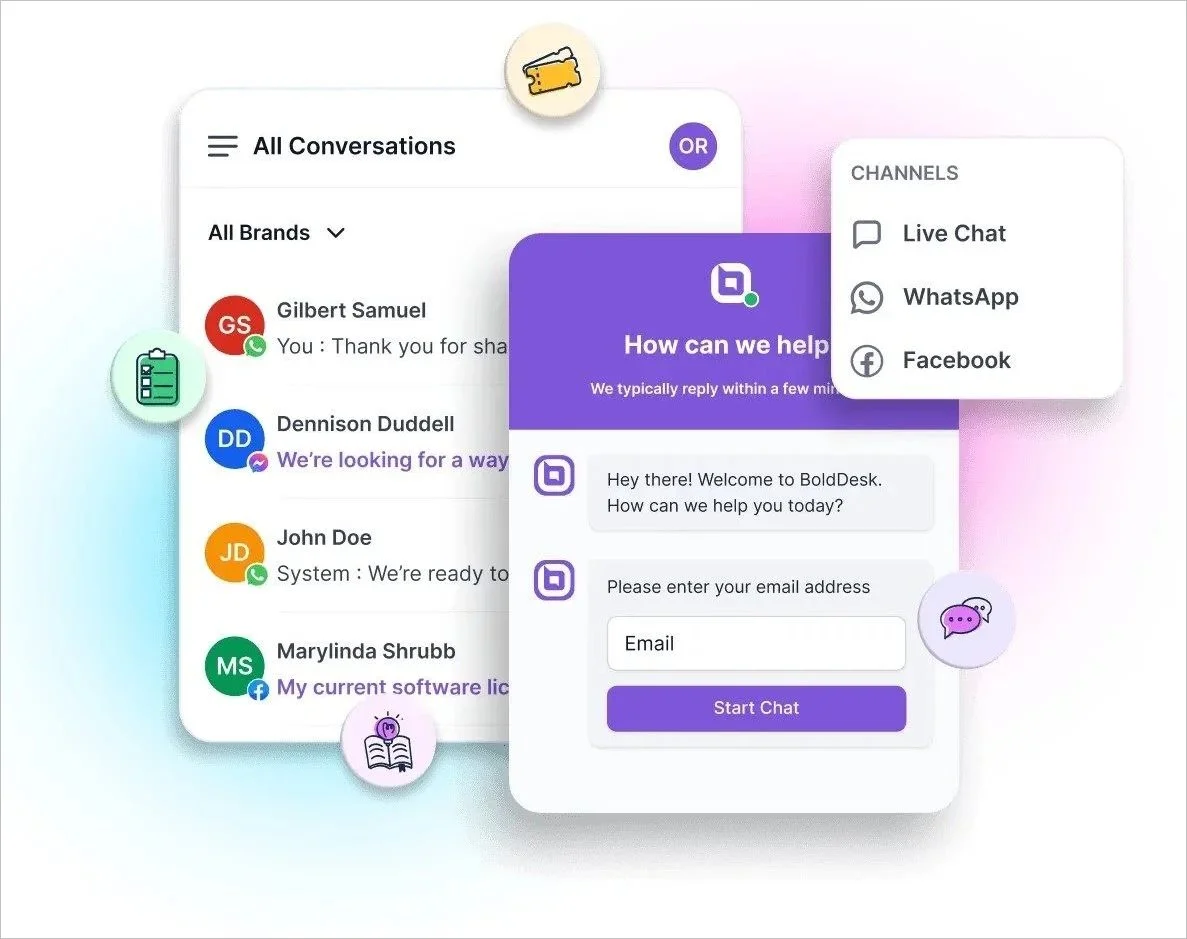
In BoldDesk’s live chat tool, customers can access their chat conversation history through email transcripts. Everyone stays in the loop every step of the support journey with delivery and read receipts.
As a business, you can also track visitor activity just before they contacted you via chat with the reporting and analytics tools to help personalize customer service.
BoldDesk also offers a mobile chat module, making it easy for agents to provide support on-the-go!
What’s more, customers are guaranteed the 24/7 customer service with the offline support feature. They can get responses even when they are inactive on chat. No more missed communication!
Features
- Customizable chat widgets
- Automated chat routing and assignment
- Chat history and email transcripts
- Chat receipts
- Multilanguage support
- Omnichannel support
- Mobile chat support
- Offline messaging support
- Collaboration tools: Canned responses and file sharing
- Reporting and analytics
- Seamless integration options
- Unlimited messaging
- Top-notch privacy and security
Pricing
- Scale: $12/agent/month
- Momentum: $25/agent/month
- Enterprise: $39/agent/month
BoldDesk’s unlimited agents plan is priced based on monthly ticket volume, starting at 500 tickets.
Choose from three options:
- Essential: $99
- Pro: $199
- Business: $399
Our exclusive program tailored for startups gives you 10 Momentum plan agents for free for your first year.
You can schedule a live demo or contact us to learn more about how you can provide fast and efficient customer support with BoldDesk’s live chat software. Experience real-time support by signing up for a 15-day free trial today!
2. Tidio
Tidio is a live chat platform that can be integrated into websites to help businesses communicate with their customers in real-time.
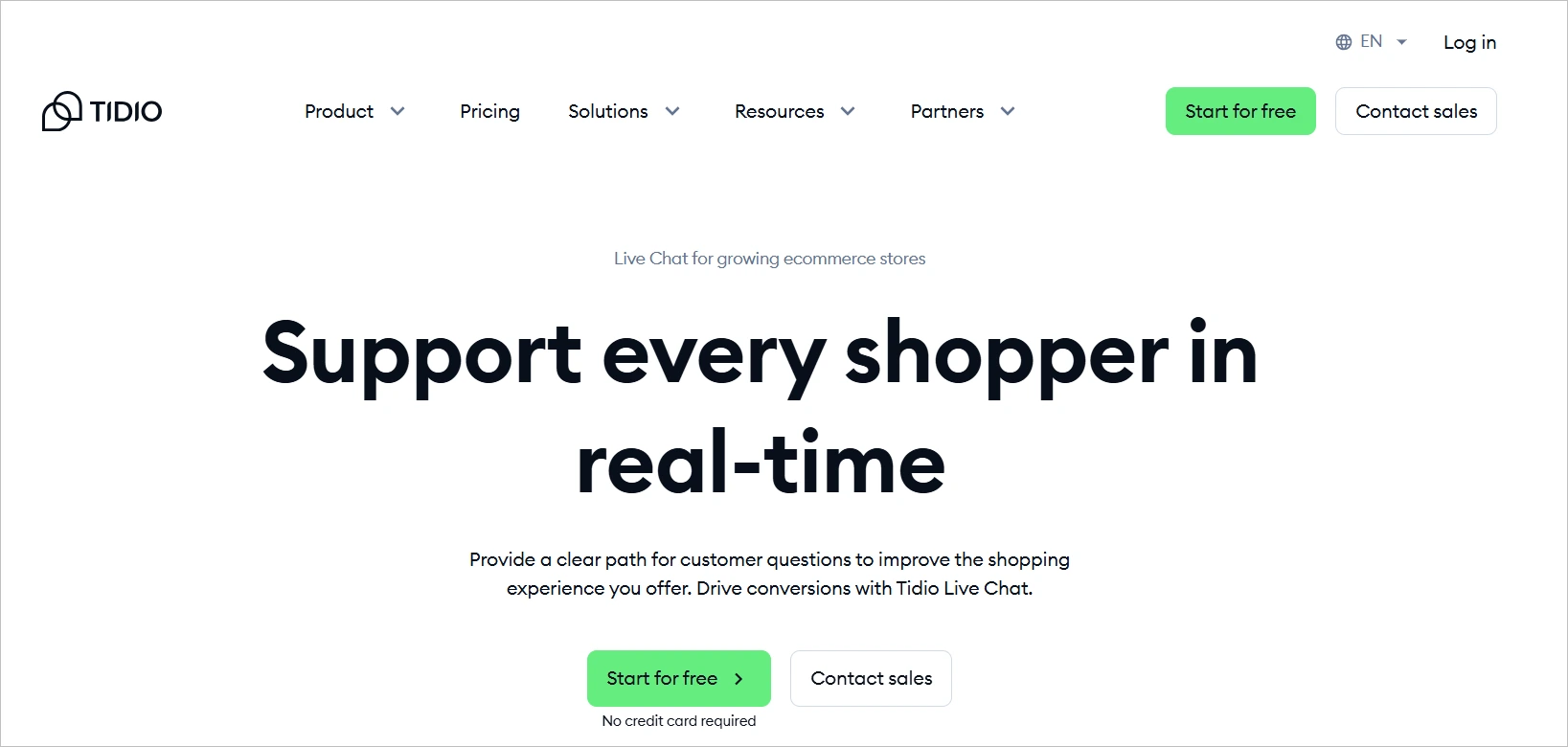
It’s a versatile tool that combines live chat widgets, bots, and marketing automation to save time and provide excellent customer service.
Features
- Customizable chat widgets
- AI assist features
- Reports and analytics
- Automated responses
- Chat templates
Pricing
- Free plan available.
- Paid plans start at $29 per user/ month.
Free trial: 7 days
3. Chaport
Chaport is a multi-channel messaging platform designed to enable companies to communicate with their clients via live chat, email, and social media, all from a single interface.
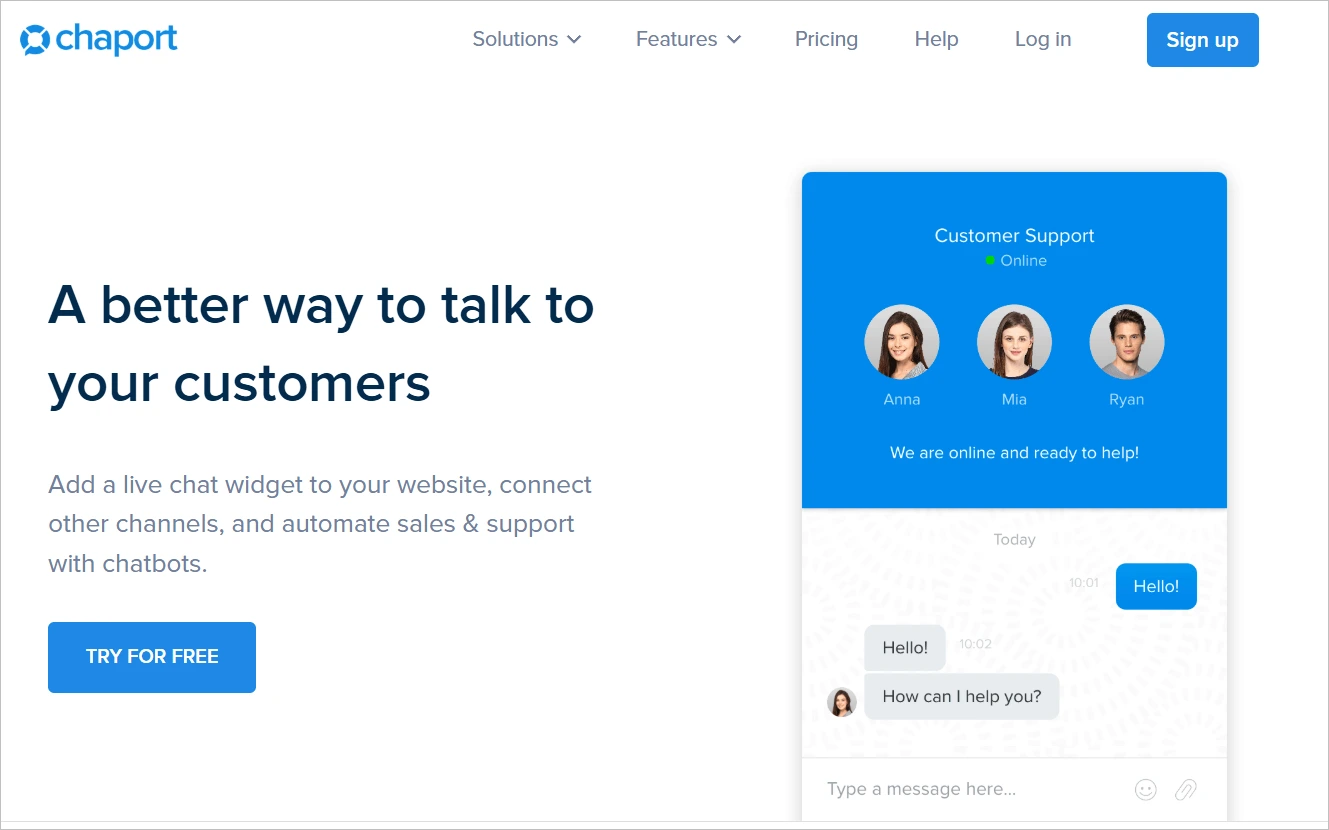
The Chaport live chat widget is a specific component of the platform that can be embedded into a website, allowing visitors to start real-time conversations with customer support teams or sales representatives.
Features
- Automated chat routing
- Customizable chat widgets
- Reporting and analytics
- Multilingual support
Pricing
- A free plan available for two operators
- Paid plans start at $29 for four operators/month
Free trial: 14 days
4. Userlike
Userlike is cloud-based live chat software solution that allows businesses to integrate a chat widget into their websites for immediate communication with visitors and customers.
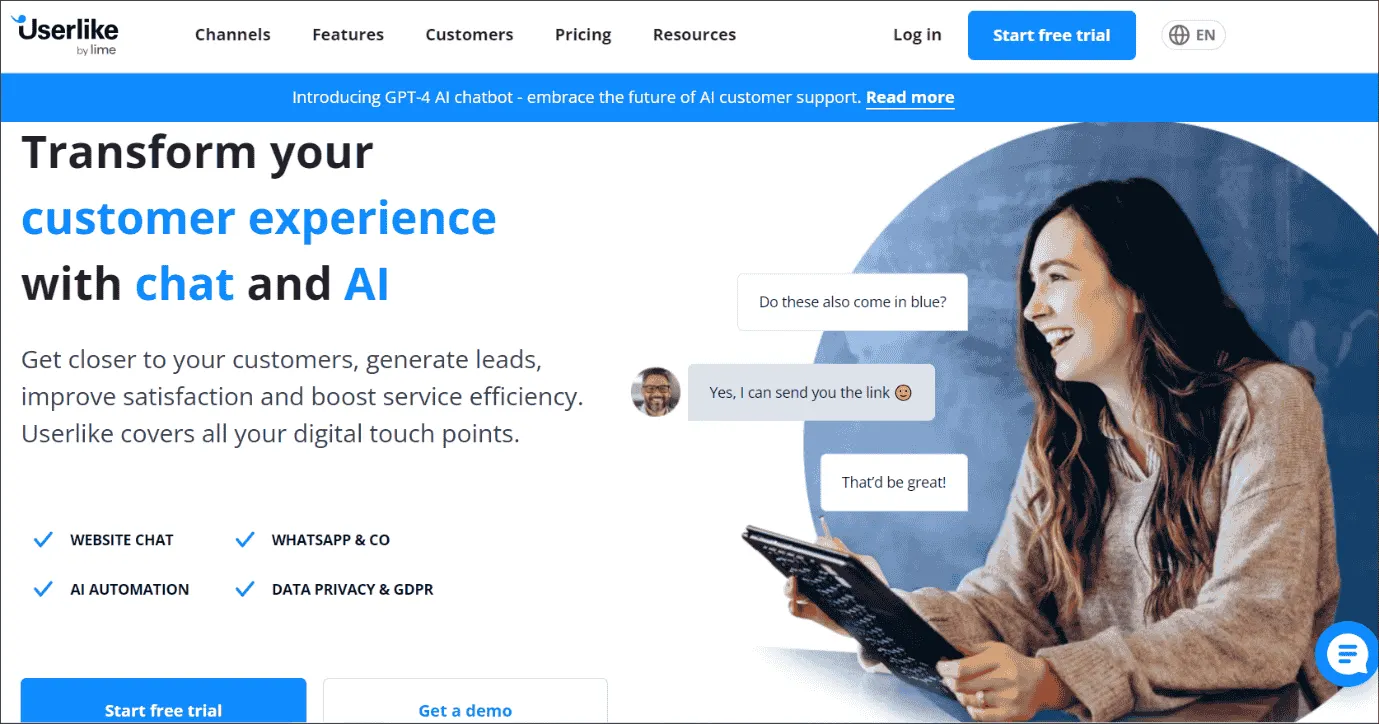
It is designed to help businesses connect with their customers in real-time, providing a seamless and personalized communication experience. It’s a popular choice for businesses looking to provide efficient and convenient customer service through multiple channels.
Features
- Customizable branding
- Auto-translation
- Proactive chat
- Automated chat routing
- Customer feedback
Pricing
- A free plan is available for one seat
- Paid plans start at $90 per month for four seats
Free trial: 14 days
5. Chatra
Chatra is a live chat widget designed to facilitate real-time communication between businesses and their website visitors.

Chatra’s live chat widget is designed to enhance customer support, improve website visitor engagement, and contribute to overall customer satisfaction for businesses of varying sizes.
Features
- Offline messaging
- Proactive chat
- Customization options
- Integrations
- Analytics and reporting
Pricing
- A free plan is available for one agent
- Paid plans start at $ 17 per user/month
Free trial: 10 days
6. Olark
Olark is a straightforward and easy-to-use live chat tool that offers features like automated messaging, real-time reporting, and searchable transcripts.
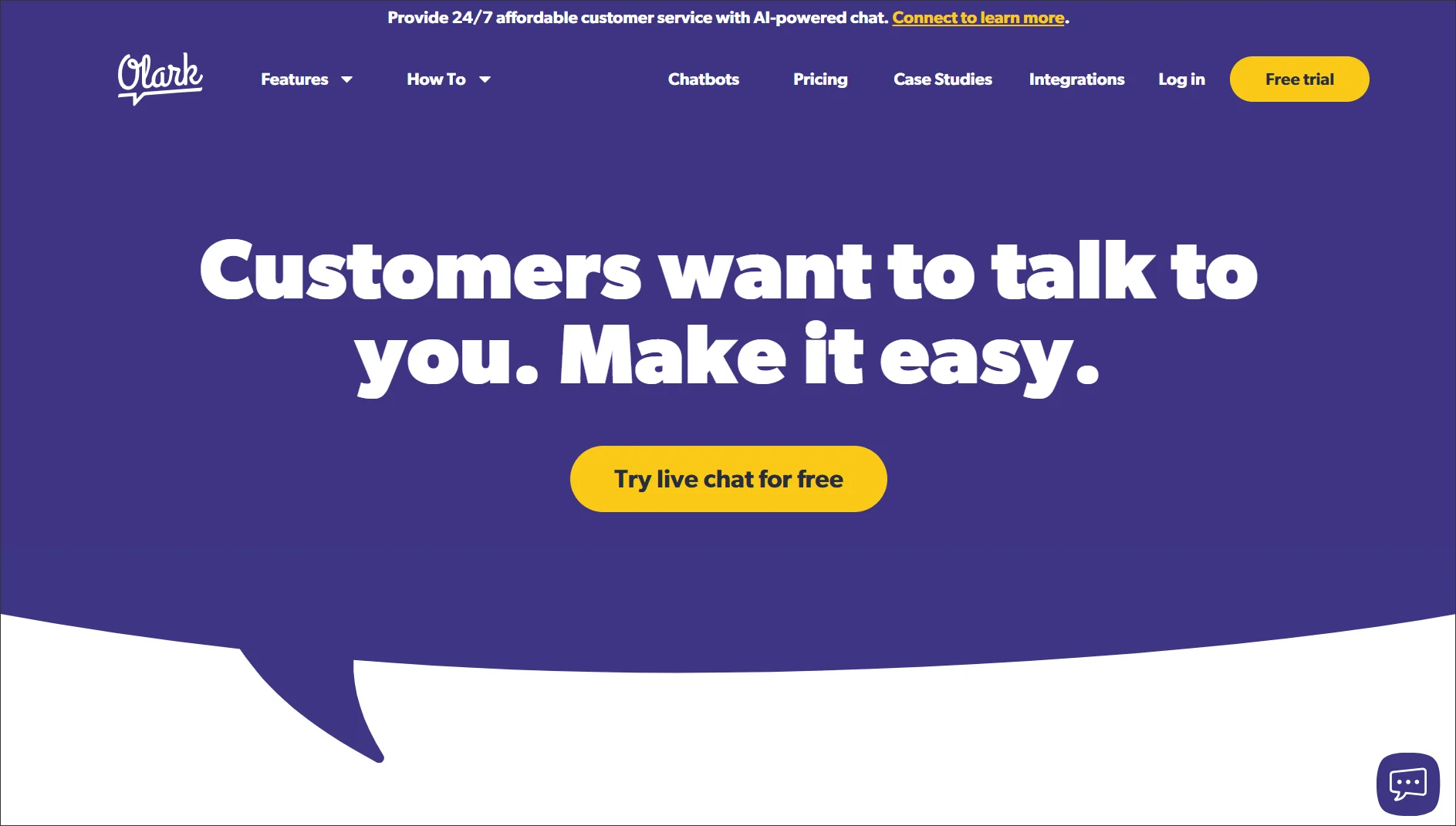
It offers a simple and easy-to-use chat widget that is perfect for small businesses.Features
- User-friendly interface
- Automated chat routing and distribution
- Automated translation
- Team performance monitoring
- Real-time tracking
Pricing
- Starts at $29 per user/month
Free trial: 14 days
7. Zendesk chat
Zendesk Chat is a live chat solution offered by Zendesk, a customer service and engagement platform.
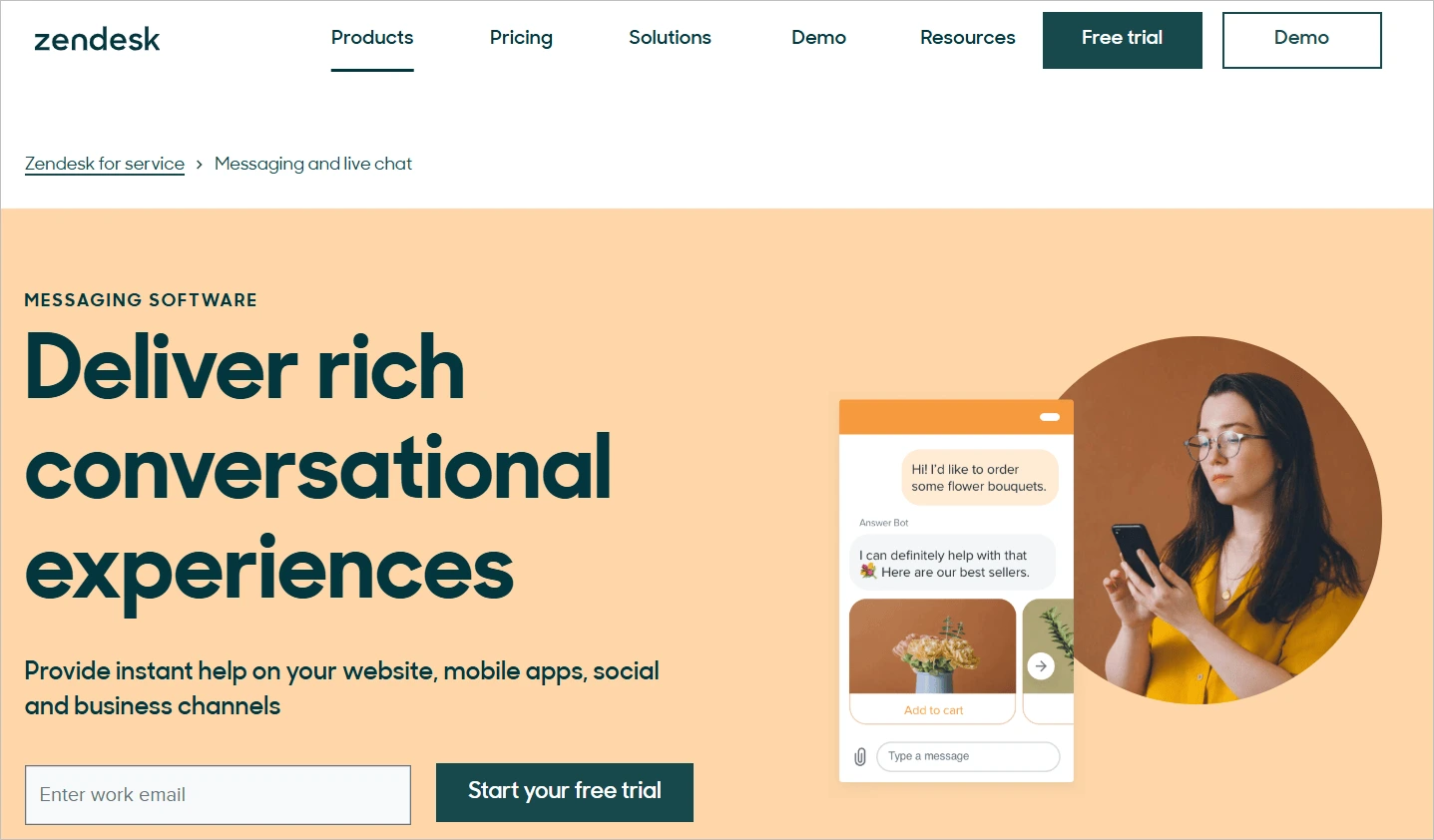
Zendesk live chat softwareIt enables businesses to communicate with their clients in real-time through a chat interface on their websites or mobile apps, providing immediate customer support and engagement. It also integrates with other Zendesk products, making it a great choice for businesses that already use the Zendesk platform.
Features
- Customizable chat widgets
- Integrations
- Automated triggers
- Reporting
- Chat tags
Pricing
- Starts at $55 per user/month
Free trial: 30 days
8. Zoho Desk
Zoho Desk is a customer service platform that includes various tools for customer support, including email, social media, live chat, and more.
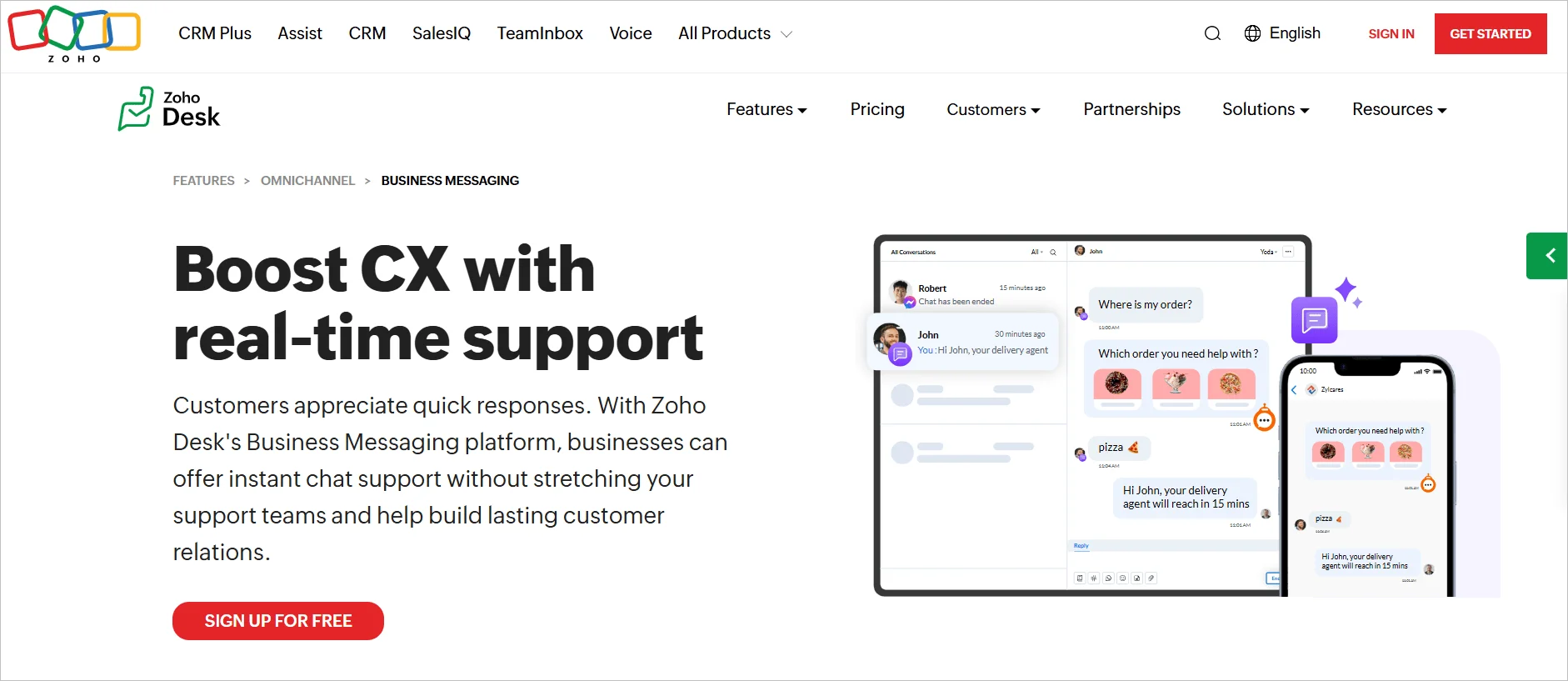
The Zoho Desk live chat widget is a feature offered within the Zoho Desk customer support platform to facilitate real-time communication between businesses and their website visitors or customers.
Features
- Customizable chat widgets
- Automated chat routing
- Reporting
- Integration capabilities
Pricing
- Starts at $18 per user/month
Free trial: 15 days
9. LiveChat
The LiveChat chat widget is a tool provided by LiveChat, Inc., which is a provider of online customer service software with live chat support, ticketing system, and web analytics capabilities.
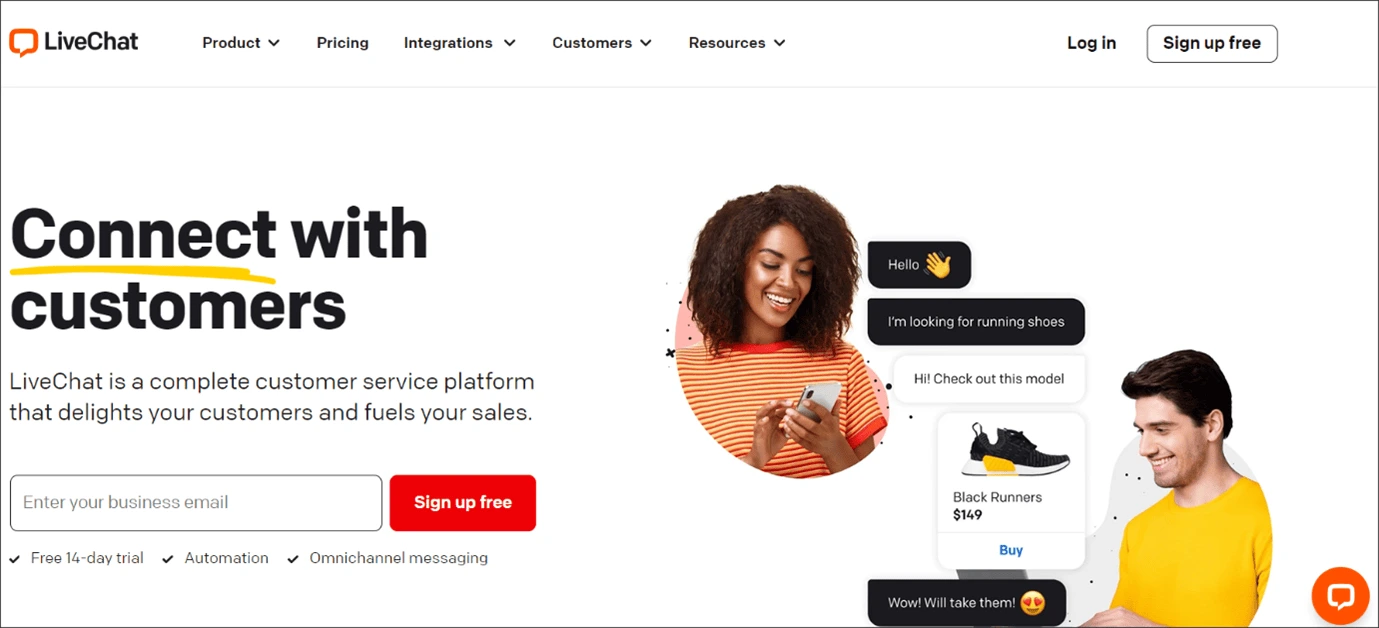
Their live chat widget is designed to be installed on websites to enable real-time communication between website visitors and customer support agents.
Features
- Customization
- Easy integration
- Advanced reporting
- Automated chat routing
Pricing
- Starts at $20 per user/month
Free trial: 14 days
10. HubSpot
The HubSpot live chat widget is a feature provided by HubSpot that allows businesses to engage with their website visitors in real-time through a chat interface.
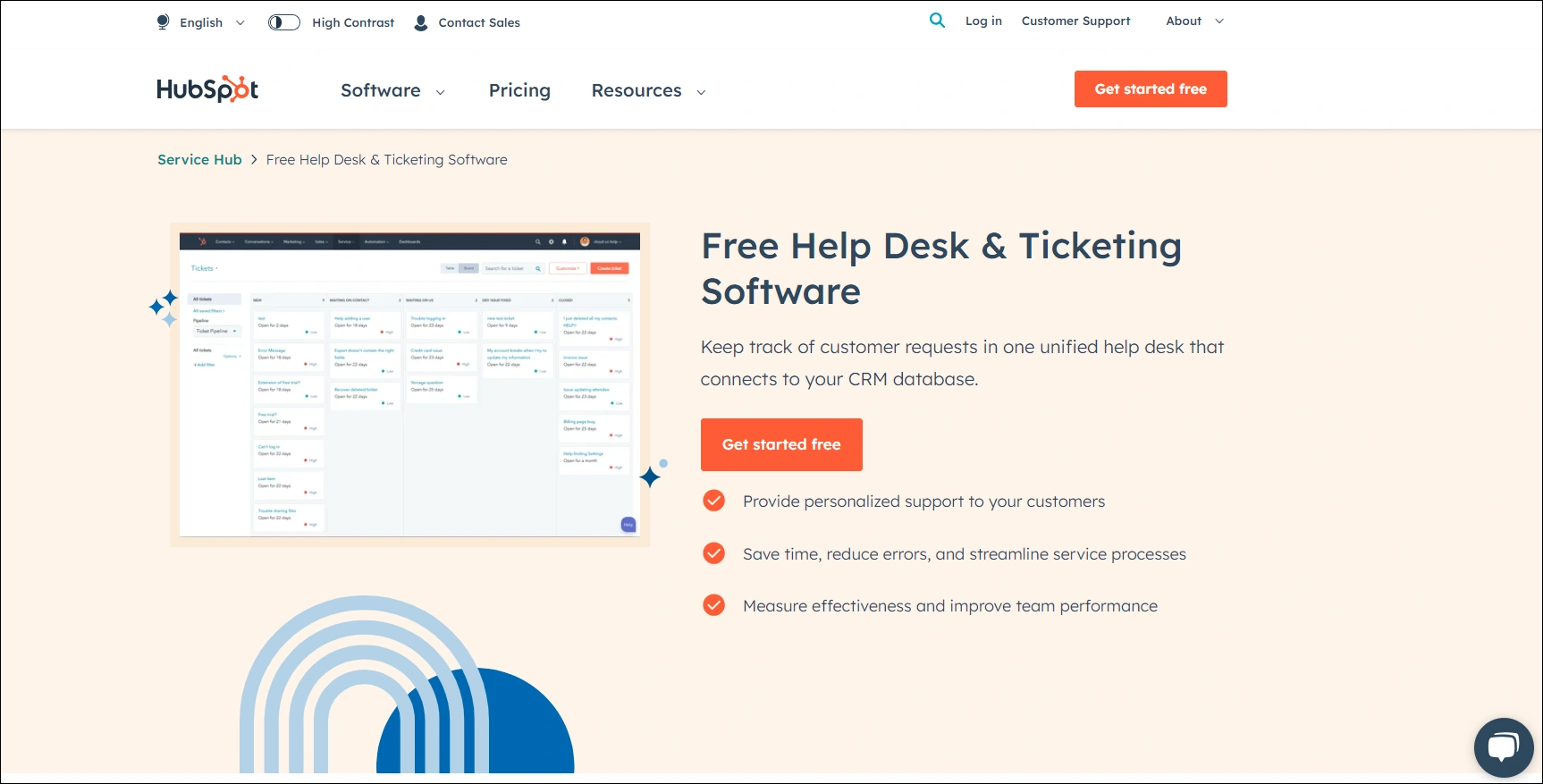
This widget can be added to any website by embedding a code snippet provided by HubSpot. Once installed, it enables visitors to start conversations with the business’s representatives or customer service team directly from the website.
Features
- Customizable chat widgets
- Conversation routing
- Analytics
- Agent performance monitoring
- Integrations with Slack and HubSpot CRM
Pricing
- A free plan is available with limited functionality
- Paid plans start at $20 for two users/month and $9/month for each additional user
11. LiveAgent
LiveAgent live chat is customer service software that includes a live chat feature among other tools such as ticketing, a call center, and a knowledge base.
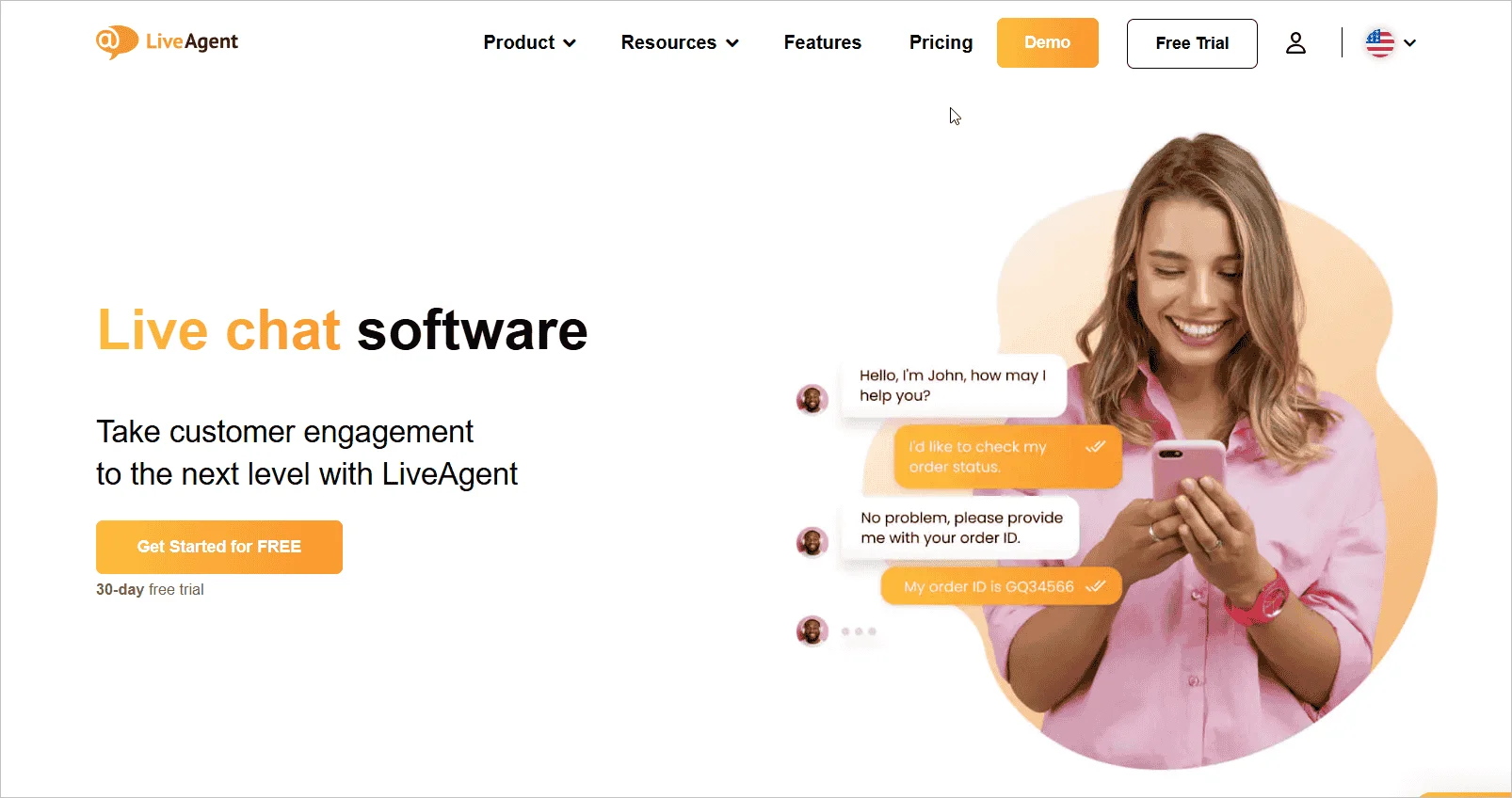
LiveAgent offers a robust live chat widget designed to facilitate real-time communication between businesses and their website visitors.
Widely compatible with a variety of content management systems and e-commerce platforms, its customizable and seamlessly connected live chat widgets allow direct connections with platforms like WordPress, Shopify, and Bigcommerce, among others.
Features
- Personalized chat invitation
- Visitor activity tracking
- Customizable chat widgets
- Animated chat buttons
- Proactive messaging
Pricing
- Starts at $9 per user/month for two live chat buttons
Free trial: 14 and 30 days for free and corporate emails respectively.
How to integrate a live chat widget into a website
Integrating a live chat widget into your website involves a series of steps. Here’s a general guide to help you through the process:
Choose a live chat platform
Before you can add a live chat widget to your website, you need to select a live chat platform. Compare features, pricing, and reviews to find the one that best suits your business needs.
Sign up for an account
Sign up for an account on the chosen live chat platform’s website. Most platforms offer a free trial period, allowing you to explore the features before committing.
Customize your chat widget
Once you’ve signed up, log in to your live chat dashboard and customize your chat widget. This includes adjusting the appearance, color scheme, and messaging to align with your brand.
Generate the chat widget code
After customization, the live chat platform will provide you with an embed code or script. This code is what you’ll need to add to your website to display the chat widget.
Add the chat widget code to your website
Depending on your website platform, the method of adding code may vary. Here are instructions for common platforms:
For HTML websites
- Open the HTML file of the page where you want to add the chat widget.
- Paste the provided embed code within the HTML body, preferably just before the closing </body> tag.
- Save and update your website files.
For WordPress
- Install a dedicated live chat plugin or use the platform’s official plugin if available.
- In the WordPress dashboard, go to the plugin settings and paste the chat widget code.
- Save your changes.
For Shopify
- In your Shopify admin, go to Online Store > Themes.
- Find the theme you want to edit and click Actions, then select Edit code.
- Locate the template or section file where you want to add your code.
- Insert your code snippet in the appropriate place.
- Save your changes.
For Squarespace
- Go to the page where you want to add the chat widget.
- Add a code block to the page.
- Paste the code snippet into the code block.
- Save and publish your site.
Test the chat widget
After adding the code, visit your website to ensure that the chat icon appears and is functioning correctly. Perform a test chat to verify that messages are being received and responded to as expected.
Configure settings
Log in to your live chat dashboard to configure additional settings. This may include setting up automated ticket routing to specific agents, defining business hours, automated greetings, and integrating with other tools.
Train your team
Prepare your team to use the live chat system. This may involve training them on how to respond to inquiries, manage multiple chats, and use any additional features provided by the chat service.
Common mistakes in live chat set up and how to avoid them
Setting up a live chat widget can significantly enhance customer engagement and support, but it’s important to navigate the process carefully to avoid common mistakes.
Here are some common mistakes made while setting up a live chat widget and how to avoid them:
Lack of clear purpose
- Mistake: Implementing a live chat widget without a clear purpose or strategy in mind.
- To avoid: Define the specific goals of your live chat, whether it’s for sales, customer support, or lead generation. Tailor the setup to align with these objectives.
Unavailable or slow response
- Mistake: Failing to respond promptly to chat inquiries or leaving the chat widget unattended.
- To avoid: Ensure that your team is adequately staffed to handle live chat. Use automated responses to acknowledge inquiries and set expectations for response times.
Overlooking the widget placement
- Mistake: Placing the live chat widget in a position that is not easily visible or accessible to the website visitors.
- To avoid: Make sure the chat button is visible on every page, preferably in a consistent location such as the bottom left or right corner, which is a standard position users expect.
Ignoring mobile optimization
- Mistake: Not optimizing the live chat widget for mobile users, resulting in a poor user experience on smaller screens.
- To avoid: Ensure that the live chat widget is fully responsive and provides a smooth and consistent experience on both desktop and mobile devices.
Using default settings without customization
- Mistake: Using the default settings and not customizing the widget to match the website’s branding and tone.
- To avoid: Customize the live chat widget’s colors, greetings, and messages to align with your brand’s identity and voice.
Ignoring chat transcripts and analytics
- Mistake: Not reviewing chat transcripts and analytics to understand customer interactions and improve service.
- To avoid: Regularly analyze chat transcripts and performance metrics to gain insights into customer needs and identify areas for improvement.
Neglecting offline hours
- Mistake: Failing to manage user expectations during offline hours, leaving them waiting for a response.
- To avoid: Set up an automated message to inform visitors of your offline status and provide alternative contact methods or an option to leave a message.
Complex interface
- Mistake: A chat interface that is not user-friendly can discourage customers from using it.
- To avoid: Ensure the chat interface is simple, intuitive, and easy to use with clear options for starting a chat, ending a session, and accessing chat history.
Intrusive behaviour
- Mistake: A chat widget that pops up immediately and disrupts the user experience can be annoying to visitors.
- To avoid: Allow users to initiate the chat themselves or set a reasonable time delay before the chat prompt appears.
Integrate live chat widget for immediate interaction with customers
By welcoming visitors with immediate support and personalized interactions, you can create a more satisfying and engaging experience, ultimately boosting your customer service, sales, and overall business success.
After carefully assessing and going through our list, you can choose the live chat widget that offers the best combination of features, usability, and value for your business.
Keep in mind that the cheapest option may not always be the best fit, and investing in a quality live chat solution such as BoldDesk can lead to improved customer satisfaction and increased sales.
We invite you to contribute your thoughts and personal experiences with various live chat solutions in the comment section below.
Related articles


















 Email Ticketing System
Email Ticketing System Shared Inbox Software
Shared Inbox Software Multi Brand Help Desk
Multi Brand Help Desk Internal Help Desk Software
Internal Help Desk Software Trouble Ticketing Software
Trouble Ticketing Software Mobile Help Desk
Mobile Help Desk 










